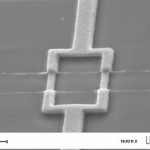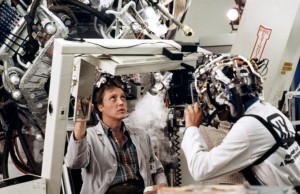A SQUID’s (superconducting quantum interference device) is an electronic system that uses a superconducting ring in which one or two small insulating layers have been inserted. This device based on the Josephson effect in the superconductor-insulator-superconductor sandwich. The flux quantization in the ring makes it extremely sensitive to any magnetic field. Squids are so sensitive they can measure the magnetic activity of the brain in real time. The majority of squids rely on conventional superconductors that operate at liquid helium temperatures, -452.2 degrees Fahrenheit.
 Fairly recently devices using the cuprate high temperature superconductors have come to market. With the creation of cuprate based SQUIDs the cooling requirements have been greatly decreased.
Fairly recently devices using the cuprate high temperature superconductors have come to market. With the creation of cuprate based SQUIDs the cooling requirements have been greatly decreased.
Using a SQUID as the sensors for a Brain Computer Interface (BCI) is not a new idea. The first time I saw this concept was in the 1983 movie Brainstorm, with Christopher Walken and Natalie Wood. The original unit they were using was a device the size of a refrigerator that you placed your head into. Its large size was due to the superconductors need to be cooled by liquid helium. Then a cinema plot device came into play, a superconducting chip that worked at room temperature, reducing the entire device to a consumer friendly, lightweight headband.
Todays exercise, creating a consumer friendly, light weight, SQUID based Brain computer Interface. Simple really …. if you look at it from an really odd angle. So it’s time to KISS KIM and do an engineering hack job on this puppy.
What do we need most to build a small lightweight BCI?
Small lightweight self refrigerating SQUID’s are the answer. I bet you knew that already.
The SQUIDs themselves are not the problem, they are manufactured using Integrated Circuit Fabrication technology, they a tiny little devices, just a couple micros across. Angels dancing on the head of a pin tiny, there are 25,400 microns in one inch. Lets ignore the SQUID for the time being, and concentrate on how to reduce the size of the refrigeration, associated insulation, and shrink it down so we can pack 20-30 of them in a headband.
To cool the SQUIDS there are four types of heat pumps to choose from, Compressor, Magnetic, Thermoacoustic, and Thermoelectric. Using a compressor is out, the weight, the voltage fluctuations, and the vibration all say poor design choice. Magnetic cooling is out the SQUID is trying to detect minute magnetic fields and this cooling method will interfere. Thermoacoustic, yeah right … no, on two counts, who wants a 20 – 40 piezo crystals vibrating on their head at high frequency all day, plus piezo crystals also give off minute EM pulses, making them unsuitable. That leaves only the thermoelectric heat pump.
Thermoelectric cooling uses the Peltier effect to create a heat flux between the junction of two different types of materials. Simply put you run DC current through it, and it pumps heat from one place to the other. The lowest temperature thermoelectric heat pumps work at is 100 degrees Kelvin. Which is wonderful because high temperature superconductors will work at temperatures up to 133 degree Kelvin.
<This was embarrassing, so it was removed>
After doing all the math I come up with a 10 stage thermoelectric cooling module, made from 4 distinct material types for the thermoelectric heat pumps, two inches deep and using 20+ watts each to cool down to 115 K, with water cooling for outermost layer of the heat pump. Which makes this an unworkable solution.
What a waste of half a day. While I have come up with a working concept, it is not a viable headband BCI unless you have a neck the diameter of a telephone pole and wouldn’t mind wearing a 15 or 20 pound hat all day.
Normally when I get an idea like this it has a workable solution. The only solution I see is higher temperature superconductors. Maybe I need a hollywood plot device…
I should contact Joe Eck over at superconductors.org and see if he actually has come up with room temperature super conductors running at 35 degree C …..yeah right, I will put that on the list right after, “contact the pyramid power guy and order a hat” ….

